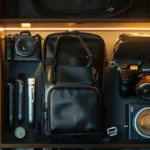Fourthly there are the tools of hunting and survival. Fire making tools, supplies to include leaves, and conks for carrying embers over long distances. Strips of bark from the birch tree and the sap of the tree. Any additional conks will also be collected and stored. Flints and additional fire starter materials will be collected to ensure warmth from the fire can be guaranteed on the coldest nights of a long winter. (Oeggl and Handley 2003)
Jadeite axes from the Neolithic Period in central Europe. Ashmolean Museum/Heritage Images/Getty Images
Fifthly my shelter will be of a multilayered construction of logs placed in recessive areas that I can backfill with dirt with the upper roof are made from hides secured in a fashion to ensure a hole vent to allow smoke to escape out of the structure. Rocks brought in from the local river will be of a certain size and a rounded shape to ensure they can be heated from the fire and placed around my body to keep me warm while sleeping. Grass from any open fields will be collected and shaped into bedding that will be covering the ground floor area and then covered with bear rugs I have collected over my numerous hunting seasons. I will also dig holes into the ground that are deep enough and penetrate to the outside of the structure where they will stay frozen yet protected from wild animals. The structure will not be very big and will be sunken into the ground as much as possible. As the snow begins to fall, I will ensure it is placed around the outside of the structure for added insulation. The inside will have a slightly tipped peak with only hides showing on the inside and the outside will be lined with small long logs adding support in a grid fashion to enable the structure to hold several hundred pounds of snow.

Stone tools found in a neanderthal flint workshop discovered in Poland. A. Wiśniewski/Nauka w Polsce
Finally, my survival toolkit of tools will be made from rocks and volcanic obsidian. My handles will come from birch trees and strips of the leather hide will be used for comfort and grips. I will have a bow with arrowheads made for the obsidian. My ax head will be made from local rock and if possible, I will have traded for a copper head fashioned in the old European style as found from the Otzi the Ice Man. This will give me greater accuracy and a sharper arrowhead point. The copper ax head will be used to create a sharp blade to be used for protection and hide processing. (Oeggl and Handley 2003)
In conclusion, the tools, technologies, and nutritional food in order to not only survive but to thrive can be gathered and organized for survival. This equipment, supplies, and shelter should allow me to survive the coldest temperatures and my gear will allow mobility for hunting or escaping from an attack in case unforeseen problems arise. My diet of high fat and limited grains will give me the calories to stay warm and to hunt wild game and fish in the winter season. My waterproofed clothing will not only keep me warm but waterproofed due to the oily outer layers. The materials used to make my clothing also blend into the natural environment with camouflage that helps me with hunting and evading human or animal predators.









